The secret lives of grizzlies
The best time Lynne Nelson entered a den of dormant grey-haired bears, she matte up a little nervous. The unfree bears had known her since they were babies, but they hadn't eaten in weeks. And apiece young-adult bee-like weighed more than 150 pounds. They weren't big, but they were definitely big sufficient to hurt her.
"I didn't know what to expect," says Viscount Nelson, a veterinarian and heart specialist at Washington State University (WSU) in Pullman. "I didn't know if they had forgotten us, if they would be fearful or hungry, or wonder wherefore we didn't bring a big load of food."
As soon as she and her colleagues walked into the den at WSU's fenced-in Bear Nub, however, they were surprised to find that the resting bears acted just like cubs: They licked the researchers' faces and tried and true to sit in their laps.
Now, geezerhood later, the grown-up captive bears still act the aforementioned way during hibernation, mayhap because they feel safe and are free from the stress of having to guard themselves and hunt for food, A they would in the wild.
Such unpaired, babylike demeanour among adult bears is not the only thing that makes grizzlies so interesting, Nelson says. For years, she has been documenting some extraordinary changes in the bears' heart activity during hibernation.
Because bear hearts work like hominian hearts do, Nelson hopes her findings might one twenty-four hour period help doctors fitter treat heart problems in people. And other research with the eight or so captive grizzlies at WSU's Bear Center might help scientists understand and protect bears in the wild.
The heart and soul of a bear
Pulse rate is one thing people make in common with grizzly bear bears. An normal human heart beats between 60 and 100 times per minute. An average grizzly's heart runs between 70 and 90 M.M. (bpm)—but only in the summertime.
A wintertime approaches, grizzlies settle down in protected dens where they bequeath hibernate for 4 to 6 months. During hibernation, the bears don't sleep all the time but they do stop eating, imbibition, and going to the toilet. They continue to move just about, but move much slowly. Over the winter, they misplace or so 30 percent of their body angle.
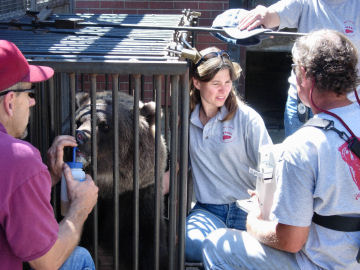 |
| Lynne Nelson and colleagues at the WSU Bear Research Center have housebroken grizzlies to get together in experiments. |
| Booker T. Washington State Department University |
Scientists birth nightlong known that a grizzly's pith rate drops to between about 5 bpm and 25 bpm during hibernation. But how can a bear's heart value rest so low for thusly longitudinal without causing any permanent terms to the animal? Information technology's a interrogate that scientists would like to answer. Such a slowly beating heart is a sign of major punctuate in a human. In fact, a soul with a heart rate that low would die.
"Wherefore don't the same kinds of stresses that would kill United States of America affect these bears?" Lord Nelson asks. "That's the billion-dollar question."
Hibernation investigating
Poring over the hearts of hibernating wild grizzlies isn't easy. Previously, researchers had to trap the bears, put heart monitors on them, and bond trailing collars so they could retrieve the monitors tardive.
Simply to get over more detailed data, today's researchers need to monitor an antelope-like's heart with special equipment. They besides motive to draw blood samples. These kinds of tests call for that an animal sit out still for at least 20 minutes at a sentence. Wild grizzly bears, however, are not known for their cooperation skills.
Researchers bear tried using anesthesia to sedate violent bears before collecting measurements. Only these drugs slow the heart, among other effects, masking the animal's natural province.
In 2001, Nelson and her colleagues decided to try a fres approach: They adoptive two 4-week-old captive female grizzlies, just as the cubs were starting to open their eyes. Bears weigh about 5 pounds at that age, Admiral Nelson says. Fully grown adult females weigh up to 450 pounds.
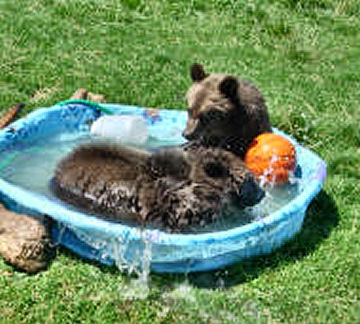 |
| Two grizzly cubs maneuver in a syndicate at the WSU Bear Center. |
| Washington State University |
In their facility in Pullman, the researchers elevated the animals. They put-upon dog-training techniques to teach the cubs how to sit, lie, and tolerate medical tests. The animals were quick learners.
"They're incredibly smartness," Nelson says. "Often, we could show them what we wanted them to do just once, and they would get it from then on. It was actually amazing."
Sleepy time
To consider hibernation, the researchers begin by reducing the amount of food the animals get. They ut this when the weather starts turning cold in October, because in the unsupported, a declining supply of food is one factor that triggers hibernation. Soon after, the bears record artificial dens made of existent and occupied with hay for warmth and consolation. There, they settle down for the winter, usually with one other expect that they choose themselves.
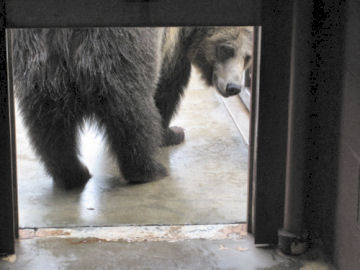 |
| At the WSU Bear Center, grizzlies can roam 'tween indoor and outdoor enclosures. |
| Emily Sohn |
Quadruplet to six weeks later, the scientists enrol the den to record nitty-gritt measurements and new data from the bears. They do the similar thing every calendar month until the weather turns warmer.
Soh far, the enquiry has revealed some surprises. The scientists get found, e.g., that a grizzly bear's heart range not only drops during hibernation simply also varies a pot. It can jump from 4 bpm i small to 25 bpm the next, and and so quick drop hinder. Horatio Nelson's studies as wel reveal that two of the four Sir William Chambers in a grizzly's heart give up beating during hibernation. The phenomenon has never been seen in some other type of hibernating animal, and scientists don't know what IT means.
In a human heart, dramatic changes in heart rate are signs that something is seriously wrong. Figuring out how and why the Black Maria of asleep bears can doh what they do and still stay healthy might give doctors clues about how to treat life-threatening heart problems in citizenry.
For instance, researchers could try to develop medicines that would allow a diseased human heart to temporarily rest, fair-and-square as a hibernating acquit's heart does. If a sick person's core didn't let to work so hard, Nelson says, he operating room she might be able to manage the disease better.
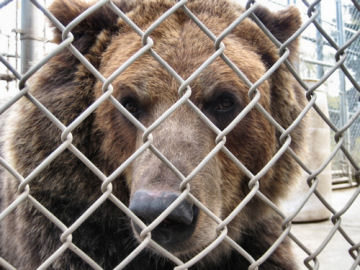 |
| Grizzly bears may have much to teach scientists about the human heart. |
| Emily Sohn |
And it's non just the hearts of hibernating grizzlies that deserve attention from the medical residential district, Nelson says. For reasons scientists cannot yet explain, bears can hibernate for months without losing strength in their bones and muscles. When people mustiness check in bed for a long time for medical reasons, on the other handwriting, they lose both bone and muscle mass. That's something doctors would like to prevent.
Acquiring the bear facts
Researching bears in a fenced-in facility can be gripping, but how much can studies of captive bears tell us about wild bears? A lot, say WSU researchers.
Graduate student Jennifer Fortin is studying what Ursus horribilis bears feed in Yellowstone Rive National Common. Historically, Fortin says, Yellowstone's grizzlies ate lots of cutthroat trout, a type of river Pisces the Fishes. But bowelless trout populations rich person crashed in recent years because of overfishing and habitat destruction. Scientists don't recognise what the grizzlies are currently eating.
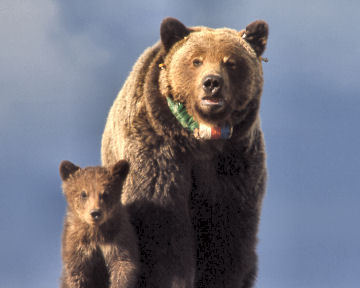 |
| Scientists read grizzlies in places such as Yellowstone Interior Park past placing tracking collars on them, like the matchless this momma bear is erosion. |
| NPS Photo past John Good |
To find out, Fortin and colleagues started with a study at the Bear Center. They fed known amounts of fish to the bears. Then, they analyzed the chemical composition of the bears' hair. From the data they collected, the researchers created a formula to link fish consumption with mercury levels in the bears' pelt. (Fish have a all-metal named mercury in their bodies that they get from the environment. When bears eat the Fish, they ingest the mercury, which later shows up in their hair.)
Next, the researchers moved prohibited into the field. They outfitted wild bears with tracking collars that allowed them to line the animals' steps. As the scientists followed the bears' trails, they collected the grizzlies' droppings and hair. Using the formula they matured in the lab, the scientists are figuring forbidden whether the wild bears are replacing cutthroat trout with other types of fish or are feeding other kinds of food instead.
Results aren't yet available, but Fortin hopes to use what she finds out to help Yellowstone's grizzlies. Once they know what the bears deplete, the park's wildlife managers can better protect the animals' food supply. In the same way, Nelson's piece of work with hibernation in the science lab might help field biologists protect bears from noise and other disturbances that might accentuat the animals in the winter.
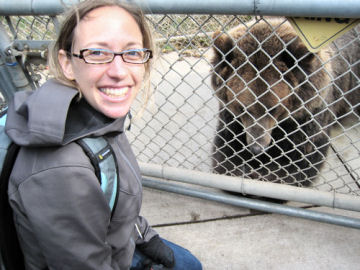 |
| Science News for Kids reporter Emily Sohn gets up enveloping and personal with a grizzly bear at the WSU Bear Center. |
| Good manners of Emily Sohn |
More than ever, some researchers aver, grizzlies want this kind of protection. In the United States outside of Alaska, grizzly take over numbers have dropped to less than 1,000. A few centuries past, the population topped 100,000.
Gray-headed bears get a lot of attention when they steal food or hurt people, Fortin says. "Simply they don't pay off enough publicity for the fact that they'atomic number 75 a unique species," she says.
"They deserve our respect," she adds. "And we have a responsibility to do our part in devising reliable that they can live as naturally as possible without our interference."
Exit Deeper:
Additional Entropy
Questions most the Article
Word Find: Undermine Digest

Post a Comment for "The secret lives of grizzlies"